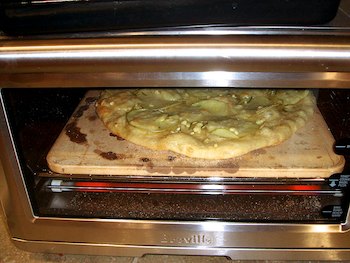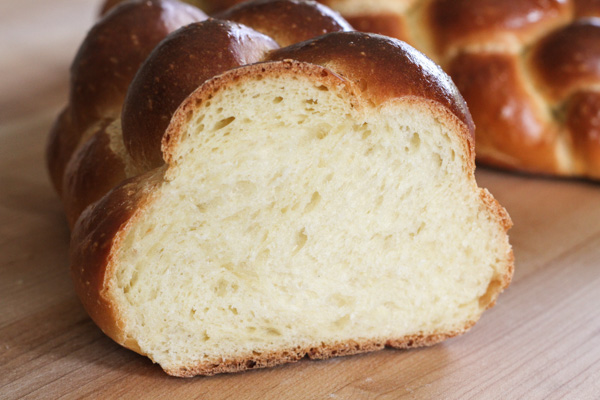
Allow me to reintroduce my old and faithful — but neglected-of-late — friend, prefermented dough.
Prefermented dough (or “pâte fermentée” if you’re a Francophile, or “old dough” if you like short words) is the decorous workhorse of the preferment family. Sourdough starter and poolish and most other preferments dawdle along at room temperature until they’re about to lose it and then childishly demand, “Use me! Right now! Or I’m going to get sloshed and start killing off the yeast! I mean it!” Prefermented dough, on the other hand, after a reasonably short heyday on the counter, retires quietly to the refrigerator and stands patiently by until called upon to do its job, which is to add strength to your dough and flavor to your bread.
Prefermented dough contains the four essential ingredients — flour, water, yeast, salt — in the proportions typical of a basic French bread dough. If you’re baking such a bread, you can save a piece of the dough and use it as the preferment in another bread. Or, as I’ve done for this challah, you can make up the prefermented dough just for that purpose. Simply mix the ingredients (no gluten development required), let the dough ferment at room temperature for one to two hours, and throw it in the refrigerator, where it will keep for up to two days. You can let it warm up for an hour or so before using it, or you can use it straight out of the fridge. In the latter case, make sure your final dough water is warmer.

This challah contains olive oil but regular vegetable oil wold be fine, too. For a slightly less rich bread, use two whole eggs instead one one egg and four yolks. I shaped my loaves as six-strand braids. Maggie Glezer has a wonderful 6-braid tutorial at the Fine Cooking website.
This prefermented dough and the challah it served go to Champa (Versatile Vegetarian Kitchen) and Zorra (1x umrühren bitte) for BreadBakingDay #37, Breads Made with Sponge or Preferment.
Olive Oil Challah with Prefermented Dough
Yield: 1000 g (2 loaves)
Time:
- Mix prefermented dough: 5 minutes
- Ferment prefermented dough: 1.5 hours, then overnight in the refrigerator, or up to 2 days
- Mix final dough: 10 minutes
- First fermentation : 2 hours, with degassing at 1 hour
- Divide, preshape, rest, and shape: 40 minutes
- Proof: 1.5 – 2 hours
- Bake: about 30 minutes
Desired dough temperature: 76F
Prefermented Dough Ingredients:
- 131 g flour
- 85 g water
- 0.8 g (1/4 teaspoon) instant yeast
- 2.6 g (scant 1/2 teaspoon) salt
Final Dough Ingredients:
- 460 g flour
- 112 g water
- 4.1 g (generous 1 1/4 teaspoon) instant yeast
- 8.5 g (scant 1 1/2 teaspoons) salt
- All of the prefermented dough, removed from refrigerator and rested at room temperature for one hour
- 34 g sugar
- 64 g egg yolk (4 yolks) at room temperature
- 53 g (1 whole) egg at room temperature
- 47 g olive oil
Egg Wash Ingredients:
- 1 egg
- 1 teaspoon water
Method:
- In a medium bowl, combine the prefermented dough ingredients together with your hands until they are well combined. Cover and ferment for 1 – 2 hours at room temperature, then refrigerate overnight, or up to two days.
- An hour before mixing the final dough, remove the prefermented dough from the refrigerator, cut it into ten pieces, and let rest at room temperature.
- In the bowl of a stand mixer with dough hook, combine all of the final dough ingredients. Mix on low speed until the ingredients are incorporated. The dough will be quite stiff.
- Continue mixing in medium speed until the gluten is nearly fully developed.
- Transfer the dough to a lightly oiled, covered container. Ferment at room temperature for 2 hours. After the first hour, gently press the dough to degas it.
- Turn the dough into a very lightly floured counter. Divide into 12 pieces of about 80 grams each (6 per loaf). Flatten each piece with your hand and roll it up into a light cylinder. Cover the cylinders and let them rest on the counter for 20 minutes.
- To form each dough cylinder into a rope, flatten it with your palm and roll it up tightly along the long dimension, sealing it several times with your fingertips as you roll. Then use the palms of your hands to roll the ropes to about 12 inches in length, with markedly tapered ends.
- Braid two loaves of six strands each and place them on a parchment-lined baking sheet.
- Combine one beaten egg with a teaspoon of water to make an egg wash; brush the wash lightly onto the braided loaves.
- Proof at room temperature, covered, for about 2 hours, until the indentation left by a light finger press remains.
- Meanwhile, preheat the oven to 380F.
- Just before baking, egg wash the loaves a second time.
- Bake for about 30 – 35 minutes, or until the crust is a shiny, deep golden brown.
- Cool on a wire rack.
Thanks Susan. I am tempted to try this bread.
Wow! This looks delicious! Great baking Susan!
I like to use prefermented dough in my breads, too. It is such a versatile preferment.
Do you use a mild olive oil?
Hello,
We bumped into your blog and we really liked it – great recipes YUM YUM.
We would like to add it to the Petitchef.com.
We would be delighted if you could add your blog to Petitchef so that our users can, as us,
enjoy your recipes.
Petitchef is a french based Cooking recipes Portal. Several hundred Blogs are already members
and benefit from their exposure on Petitchef.com.
To add your site to the Petitchef family you can use http://en.petitchef.com/?obj=front&action=site_ajout_form or just go to Petitchef.com and click on “Add your site”
Best regards,
Vincent
petitchef.com
That challah is stunning! Beautiful color and great braids! Glad to see you enjoyed it just as much as I do…
what a beautiful braid!
Oh My Goodness, Susan, this challah is the poster boy for all the challahs out there. I can’t take my eyes off that crumb. Honestly, I appreciate the beauty of this bread, vividly remembering that my one challah I’d baked was about half the height of yours and the braiding was something I work hard at forgetting I’ve ever attempted.
Beautiful Susan! Had wondered about the reason to use preferment dough…now I know and it makes perfect sense. Not sure I will ever master the 6 strand braid but love yours. Great crumb, too.
What an elegant challah! And with old dough too. I bet it tasted fantastic.
Wow, Susan. Is there a bread you haven’t mastered? 😉 I’m still trying to get a decent challah braid. So far, I’m not doing very well. This post has me inspired to try again.
Susan, this is one gorgeous loaf of bread. I’ve bookmarked it to try on a day when I feel adventurous. I hope you have a wonderful weekend. Blessings…Mary
This is a very interesting mixing technique for challah. I have let the whole challah dough sit in the fridge for a day, shaped the dough, and then let the loaves rise in the fridge. I get lots of flavor that way.
I found this on youtube how to do 6 strand braiding,looks easy.Now I’ve got to go try it.
http://www.youtube.com/watch?v=aaQDfG15KL4
Gosh, these are gorgeous. Have not seen a challah with pre-ferment before, it’s very intriguing. Have tried the braiding with 4-,5- and 6-braids, but have not really managed well past 4. These are an inspiration.
Hi Susan, I’ve been making the Hungarian version of challah called kalacs for years. It’s made with butter and milk and fewer eggs and it is a family favorite. But this version is a revelation! It’s the lightest loaf of any kind i’ve ever made and it was still so strong when it was rising, i could’t believe it! Thanks for the recipe and all the others, your Norwich sourdoughs are our staples.
Is there a difference by “Zopf” and Challah? i’m from Switzerland, and a “Zopf” (also Butterzopf) ist the most common bread eaten here 🙂 Thanks!
I think someday soon I’m going to have to break down and buy a digital scale. This looks great.